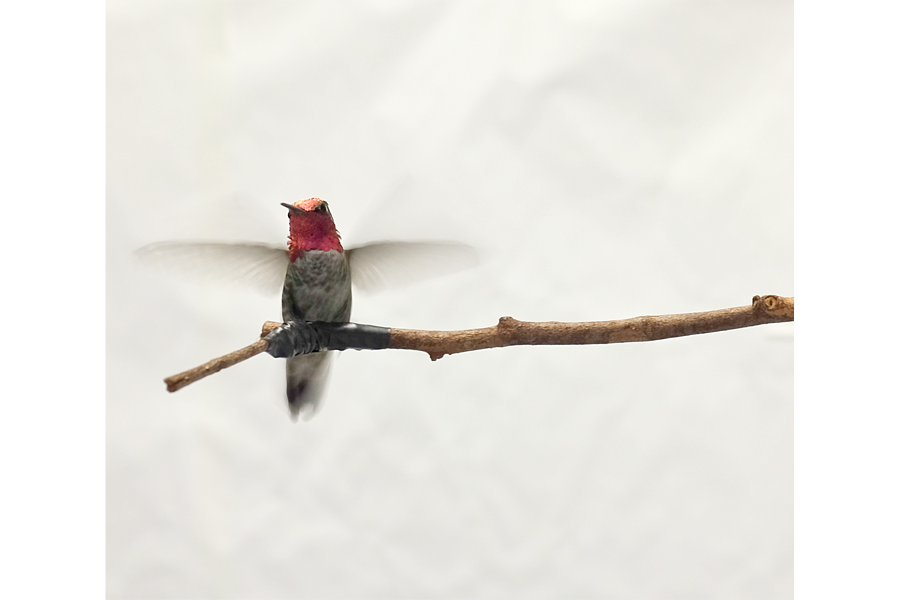How do hummingbirds navigate at such high speeds without crashing?
Loading...
Hummingbirds dart around in colorful blurs, twisting and turning their flight and stopping on a dime, all at top speeds. Anna's hummingbird, native to the West Coast of North America, can even clock in at speeds of 60 miles an hour.
Humans traveling at those speeds are on long, straight highways with no obstructions. But hummingbirds don't need a double yellow line painted on tarmac to zip around tree branches and leaves along complex paths with ease. So how do the itty-bitty fliers avoid collisions?
The tiny birds actually use sophisticated visual clues to determine just how far away objects are, according to a new study published Monday in the journal Proceedings of the National Academy of Sciences. But the hummingbirds didn't use the cues researchers expected.
Some insects, like bees, determine distance by how quickly an object passed through their field of vision. For example, when we drive, telephone poles along the road will appear to pass more quickly than a skyscraper set back miles from the road.
To test how the zippy Anna's hummingbird used visual signals, the scientists set up an 18-foot-long flight chamber in the laboratory. At one end of the tunnel was a perch and at the other was a feeder.
"Hummingbirds are sugar fiends – they have to take a drink every ten to fifteen minutes," study lead author Roslyn Dakin, a postdoctoral researcher at the University of British Columbia, told Gizmodo. "That means we can put a bird in a chamber and get him to fly back and forth hundreds of times over the course of a day."
As the hummingbirds flew back and forth, the researchers projected different patterns on the walls of the tunnel. Some of the patterns were still, while others moved.
If the birds navigated like the bees, the researchers would have expected to see the little birds steer based on how fast a pattern moved past them horizontally (like the telephone poles or skyscrapers). But they didn't respond to that kind of stimuli.
Instead, the hummingbirds changed course based on the varying size of the "objects" projected around them.
For example, when a pattern on the right wall of the tunnel depicted larger sized features than on the left, they navigated left to avoid the perceived obstruction.
Here's how the researchers think it works when a hummingbird flies along in a wild environment: If the birds are noticing how large an object appears in their field of vision, they are likely noticing how quickly it is changing in size and using that information to determine how far away they are from an object. For example, a tree just a foot away would expand more quickly in a bird's field of vision than one 15 feet away. So a bird could use that information to know when to make a course correction away from the 'expanding' tree to avoid a collision.
"When objects grow in size, it can indicate how much time there is until they collide even without knowing the actual size of the object," Dr. Dakin said in a press release. "Perhaps this strategy allows birds to more precisely avoid collisions over the very wide range of flight speeds they use."
And, in contrast to our own horizontally-oriented navigation, the birds focused on the vertical.
“We found in our study that vertical position and size (i.e., aspects of the vertical axis) were especially important to hummingbirds,” Dakin says in an email to The Christian Science Monitor. “This may be because, as flying animals, that vertical dimension is much more important to them (whereas without the help of technology, we are stuck navigating on the ground).”
Hummingbirds’ darting flights are particularly impressive because their eyesight isn’t quite as sharp as other animals.
“Small animals like hummingbirds that have much smaller eyes and a more limited ability to resolve individual features, because the size of the retina limits the number of photoreceptor cells that detect light,” Dakin says. “You can think of the number of cells as corresponding to the pixel resolution of a camera (theirs is much lower).”
And, with all that zipping around, it’s more likely that everything's a blur to the tiny birds.
But both resolution problems may be solved by the focus the hummingbirds apparently pay to feature size, says Dakin. “We don't yet know if this finding is specific to hummingbirds or whether other birds also use a similar strategy – it would be interesting to test other species to see if birds with different styles of flight use different strategies to navigate.”
Dakin’s research began as an explanation of wonder, as she and her colleagues tried to figure out just how these four-gram birds performed such feats of aerial acrobatics. But these findings could help in other ways.
Perhaps nature’s tiny fliers could inspire better navigation systems for human-made flying vehicles, she says. Or this research could help smooth out the interactions between human society and wildlife.
“Understanding how birds avoid obstacles can help us figure out better ways to prevent them from colliding with man-made structures (such as glass buildings, powerlines, or wind turbines... glass in particular kills millions of wild birds per year in North America),” Dakin writes.
[Editor's note: This report has been updated to clarify the methods and implications of this research.]







